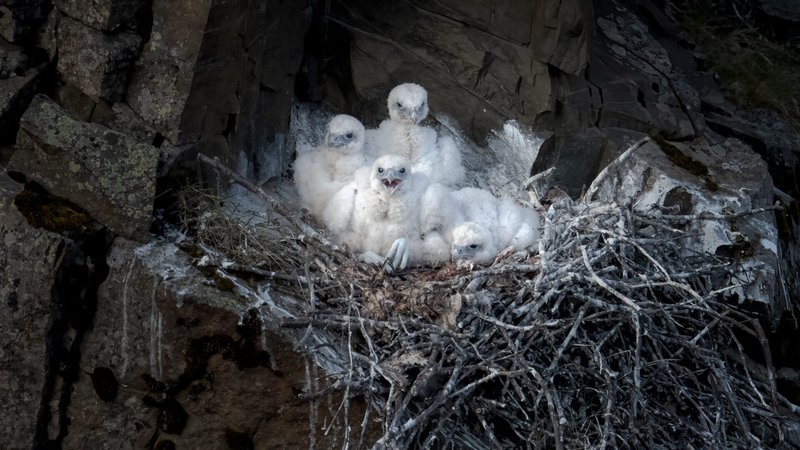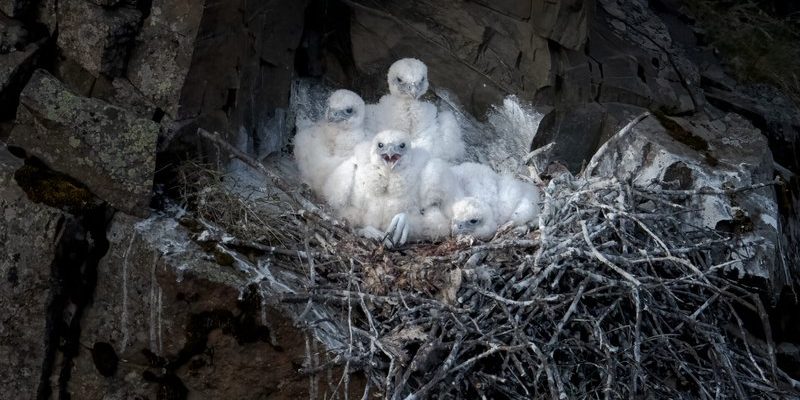
Imagine living in the remote tundras of the Arctic or the rugged cliffs of northern mountains. That’s home sweet home for the gyrfalcon. Their nesting strategies are a blend of instinct and necessity, allowing them to thrive in these challenging habitats. In this article, we’ll dive deeper into the exciting world of gyrfalcons, breaking down how they build their homes, care for their young, and navigate the challenges of their environment. So, grab a cup of coffee, sit back, and let’s unravel the life of these magnificent birds!
Where Do Gyrfalcons Nest?
Gyrfalcons are well-adapted to some of the most extreme climates on the planet. You’ll primarily find them in the Arctic regions of North America, Europe, and Asia. What’s fascinating is their choice of nesting sites. Unlike many birds that build intricate nests in trees, gyrfalcons prefer open ledges on cliffs or steep rock faces. They have a knack for finding the safest, most inaccessible spots to lay their eggs, keeping them safe from potential predators.
In some cases, these birds may utilize abandoned nests from other species, like ravens or eagles. It’s like finding a cozy second-hand apartment! This not only saves them time and energy but also offers a good structure to start their family. Imagine moving into a place with a good view and easy access to food—that’s what nesting in an old nest can provide.
Another interesting aspect of their nesting behavior is their preference for the northern tundra. The summer months, when prey is abundant, is when they set up their nesting sites. You might be wondering how they manage such harsh weather during the long Arctic winters. Their nesting areas are often located where sunlight can warm them during the brief summer, making it easier to raise their young.
The Gyrfalcon Egg-Laying Process
When it comes to reproduction, gyrfalcons usually lay their eggs in late April to early June. The female typically lays between three to five eggs, which she incubates for about **30 to 32 days**. Here’s where you might think about the classic “chick hatching” scene from a movie, but it’s a bit more intense in the wild!
During this incubation period, the female relies on her partner to bring her food, which mainly consists of birds and small mammals. This division of labor is crucial. The male is out hunting while the female keeps the eggs warm, ensuring that the little ones develop safely. It’s like a well-coordinated team job; one is focused on bringing home the bacon, while the other is nurturing the future generation.
Once the eggs hatch, the chicks are altricial, meaning they’re born featherless and entirely dependent on their parents. This stage is critical, as the parents must now provide not just warmth but also a steady supply of food. The male, in particular, plays a significant role during this time, often bringing more food than the female can consume.
Gyrfalcon Chicks: Development and Fledging
The first few weeks after hatching are a whirlwind of growth for gyrfalcon chicks. They’re pin-feathered and quite helpless at first, relying entirely on their parents. Within a week or two, you’ll start to see them grow their feathers and gain strength. Imagine a toddler taking their first steps—they’re wobbly but learning fast!
By about three weeks old, the chicks begin to open their eyes and move around the nest more confidently. This is when their unique personalities start to shine. Some might be adventurous, peeking over the edge of the cliff, while others are content to snuggle up with their siblings. It can be heartwarming to watch them bond and develop.
As they reach around six weeks, the young falcons are almost ready to fledge. This term refers to the point when they leave the nest for the first time, ready to take their first flight. It’s a thrilling moment. Picture a young bird nervously hopping to the edge of the nest, contemplating that leap of faith. Once they take to the skies, they’ll be learning to hunt and navigate the vast wilderness that’s now their playground.
Challenges Faced During Nesting
Even with their impressive adaptations, gyrfalcons encounter numerous challenges during their nesting season. Weather is a significant factor; sudden storms or unseasonably cold temperatures can threaten both the eggs and the young. Imagine a sudden snowstorm hitting just as the chicks are hatching—it’s a race against time to ensure they’re safe and warm.
Another more human-related challenge is habitat disturbance. As the world becomes more industrialized, construction and human activity in these remote areas can disrupt their nesting sites. It’s like setting up a picnic in a busy park; the noise and activity can scare the birds away or even cause them to abandon their nests.
Finally, food scarcity during certain periods can also impact their ability to raise young successfully. For example, if there’s a sudden decline in prey species due to environmental changes, the gyrfalcons might struggle to find enough food to feed their growing chicks. It’s a delicate balance, and every season brings its own set of challenges.
The Lifespan of a Gyrfalcon
In the wild, gyrfalcons can live up to **15 years**, although many do not survive past their first few years. The survival rate of chicks is heavily influenced by their parents’ hunting success and the availability of food. Interestingly, adults tend to form lifelong bonds with their partners, returning to the same nesting sites year after year. It’s touching to think about how they maintain these connections.
While in captivity, some gyrfalcons have been known to live even longer, thanks to a steady food supply and protection from natural threats. However, they thrive best in their natural habitat, where they can showcase their beauty and prowess as skilled hunters.
Understanding the lifecycle of the gyrfalcon helps us appreciate the complexity of their existence. It’s not just about finding a mate and raising young. These birds must navigate a world filled with challenges, and their resilience is something we can learn from.
Why Gyrfalcon Conservation Matters
As you reflect on the majesty of the gyrfalcon, you might be wondering why their conservation is so crucial. The truth is, these birds are indicators of the health of the ecosystem. When their populations are thriving, it often means that their habitat is also in good condition. However, as their numbers decline—due to habitat destruction, climate change, and hunting—this signals a need for immediate action.
Conservation efforts focus on habitat preservation and legal protection. By safeguarding their nesting sites and ensuring a plentiful food supply, we can help maintain healthy gyrfalcon populations. It’s like taking care of a delicate garden; with the right care, it can flourish beautifully.
Additionally, educating people about the importance of these birds plays a role in their survival. Raising awareness about the challenges they face encourages people to appreciate their beauty and support conservation initiatives. Every little effort counts, and together, we can help protect the gyrfalcon for future generations.
In conclusion, the life of a gyrfalcon is an intricate dance of survival, instinct, and adaptation. From their extraordinary nesting habits to their fierce dedication as parents, they embody the spirit of resilience. So, the next time you think about these magnificent birds, remember the incredible journey they undertake every breeding season—one filled with challenges, triumphs, and the beauty of nature.

